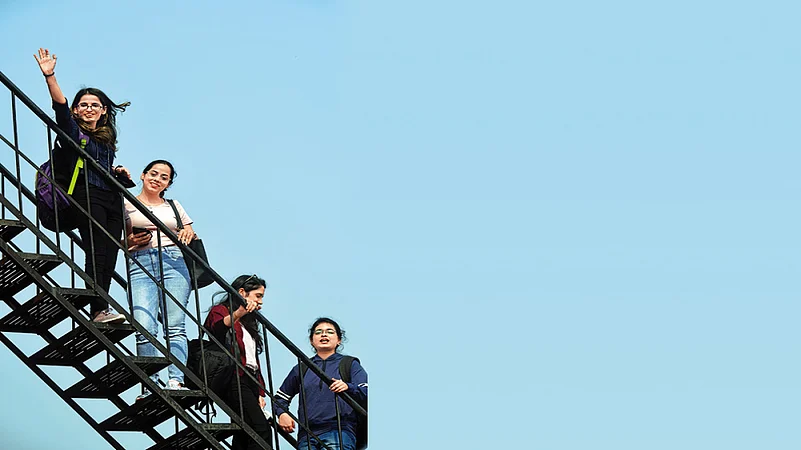The 21st century has largely been dominated by a society that is driven by information and knowledge. Industrialisation and economic expansion of this century are causing technological transformations all over the world. Today, monodisciplinary dominance in knowledge systems is being supplanted by cross-disciplinary programmes that have broadened intellectual frameworks for the understanding of nature and society. Universities are expected to play a key role in social transformation, breaking the stranglehold of a single disciplinary and intellectual framework that has dominated since the 19th century. Education is a critical factor in the development of society, by bringing technological and economic growth. Optimal growth of society can only be achieved if the status of education in society is improved, allowing for multi-faceted development of its citizens. Higher education is critical for societal aspirations, developmental priorities and societal values, all of which must be assessed, nurtured and refined regularly.
With over 45,000 higher educational institutions, India has the world’s largest higher education system, owing to a massive expansion in the higher education sector, which has seen a four-fold rise since 2001. However, the sector continues to face challenges such as insufficient funding, lower graduate employability, poor teaching standards, poor governance and complex regulatory processes. India’s demographic trend indicates it will soon overtake China as the world’s most populous country, and demand for higher education will follow suit in the coming years.
The Indian higher education system, which was originally designed to serve a select few, must now be prepared to serve a large number of people. Change and innovation would be required, as well as a critical understanding of that change. India currently has 1,043 universities, which are divided into 49 central universities, 405 state universities, 135 institutes of national importance, 126 deemed to be universities and 328 private universities; along with 42,343 colleges and 11,779 stand-alone institutions. The numbers continue to rise.
Currently, the total enrolment in higher education is estimated to be 38.5 million with 19.6 million male and 18.9 million female students. Female students constitute 49 per cent of the total enrolment. We can’t deny that by 2025, India will have the world’s largest population enrolling for higher education, and that by 2030, it will be one of the world’s youngest countries with the largest population pursuing higher education.
The Challenges
Although India’s higher education system is one of the world’s largest, it faces numerous challenges, including quality of teaching and learning, public-private partnerships, entry of foreign institutions of higher learning, increasing research capacity and funding, innovations, increasing internationalisation, changing demands of a globalised economy, etc. Despite significant efforts over the past two decades, to meet growing demands in higher education, newer challenges continue to emerge, often because of the actions of an increasingly informed and demanding population.
According to the All-India Survey of Higher Education (AISHE), India’s gross enrolment ratio (GER) is 27.1 per cent (AISHE, 2019-20), which is calculated for the age group 18-23 years. This is significantly lower than the global average of 36.7 per cent. There is also a big gap between education obtained and skills required in employment, primarily due to lack of quality in higher education institutions (HEIs), as well as a lack of skill development in the curriculum. In addition to this, the greatest challenge HEIs face today is a shortage of instructors. It is believed that 30-40 per cent of faculty positions in HEIs are unfilled, primarily due to the non-availability of well-qualified faculty. As a result, the student-teacher ratio becomes unbalanced. The scarcity of well-qualified faculty adds to the pressure of providing high-quality instruction, resulting in gaps in the learning process. Funding for government and government aided HEIs has, in recent decades, been skewed in favour of central universities. There is a need to strengthen quality assurance systems that are aligned with a sense of accountability to stakeholders. This will result in a higher number of graduates with better employability.
Separating research and teaching requires sufficient effort, which could boost the early-stage research experience. There is a pressing need for flexible curricula that are in step with changing times, as well as increased employer involvement in course content and skill development. In addition, opportunities for interdisciplinary learning must be made available. Lack of quality teaching, and outdated material and pedagogy have all been exacerbated by a scarcity of well-trained faculty. Students must be given ample opportunity to develop a broader array of transversal skills, such as analytical reasoning, critical thinking, problem-solving and collaborative working, through pedagogies and assessments that are not solely focused on input or rote learning. Due to a lack of opportunities for multi-disciplinary research, there is a scarcity of quality researchers in both sciences and social sciences, which has hampered effective interaction with industry.
Addressing the various challenges in HEIs need creative and unconventional thinking. In today’s technology-driven environment, there are plethora of resources available in the form of open education resources (OERs) and massive open online courses (MOOCs) with quick response codes (QRCs) pointing to a variety of learning resources. In the post Covid-19 era, when social distancing has become the new normal, use of online resources and remote learning tools has become even more relevant and prominent. In a situation where using the internet is unavoidable, it is prudent to use the most appropriate resources available. Faculty must be trained to be enthusiastic, innovative, willing to experiment and well-equipped to teach using technology.

The current governance models hinder autonomy of HEIs, not only because government and regulatory bodies want to micro-manage universities, but also because they have weak quality assurance mechanisms, funding that are not linked to institutional performance, and an absence of uniform transparent mechanisms. There is a need for new governance models to achieve excellence in higher education through professional management. Key characteristics, such as transparency, equity, accountability and inclusiveness, must be practised by HEIs. HEIs should also move towards decentralised governance having autonomy, accountability, flexibility, effective communication, trust and transparency at various levels of operation. To create efficient, future-ready universities, regulators must act as enablers to contribute to the progress of HEIs.
As a result of the internationalisation of education, along with globalisation and competition, HEIs must abandon traditional university administration, which is based on 19th-century tools, and adopt modern professional governance. Administrative machinery that lacks necessary skills, knowledge and attitude, and is out of step with the needs of a progressive society, can stifle a university’s development. Flexible, transparent, decentralised, autonomous and accountable governance, on the other hand, can be a powerful factor in accelerating progress by responding to changing societal needs and global trends.
Vice-chancellors, directors, registrars and other secretarial staff in HEIs are among the educational administrators for whom professional and administrative training is currently unavailable. HEIs are poorly run and lack professional management. There must be a shift in higher education towards professional management, to effectively manage the system. Vice chancellors should attend leadership programmes; other administrative staff should be required to attend formal training programmes in university administration; and academic staff should be required to attend faculty development programmes. The effectiveness of governance models used by HEIs affects recruitment, training and retention of proactive administrators and academics. HEIs should be encouraged to establish human resource management departments as service departments to manage human resources, both academic and administrative, to ensure efficient governance. Academic planning, recruitment methodologies including headhunting, retention strategies, staff development and training, personal and professional counselling, must be adopted. To focus on quality teaching, research and learning, an effective grievance redress system must be in place to address problems of students and employees in safety, security and facilities, among other things.
There is also a pressing need to conceptualise and implement e-governance programmes, as well as to develop an ERP system for universities to ensure a smooth flow of information between administration and students, staff and public, as well as to improve speed and quality of internal operations, while also providing a user-friendly interface for outsiders. With measurable results in terms of a substantial reduction in use and movement of paper, time taken to provide information, reduced delays, cost savings, environmental conservation and use of information and communication technology (ICT)-enabled tools, productivity, efficiency and customer satisfaction would improve. Verification of academic transcripts via traditional time- and labour- consuming methods must be consigned to the past. Institutions must employ modern tools using AI and blockchain to accomplish tasks faster, quicker and cheaper, with greater efficiency and trust.
The teaching-learning process must be effective for all students to achieve defined learning outcomes and graduate attributes that have a long-term, significant and positive impact on their thinking, conduct and attitude. This is at the heart of the educational system and is essential for promoting high-quality higher education. To change prevailing pedagogic practices, teachers must be trained in technology-enabled services and provided with institutional support. It is also critical that HEIs use the best teaching-learning practices from around the world. Promoting effective global pedagogies and assessment practices, continuing professional development for faculty, and developing technology-enabled learning ecosystems that are appropriate for current and future needs, are all important factors in ensuring best teaching-learning processes. Overemphasis on external assessment of students with insufficient formative assessments was a major issue during the Covid-19 crisis. A mismatch between degrees and competencies has resulted in a crisis of legitimacy for examination and qualification systems. Learning assessment must become an assessment for learning. In this context, the teacher’s role is to assist each student in developing their learning style. When learning opportunities are created for students with clear goals and teachers are involved, learning will occur. Individuals’ innate qualities must be assessed based on their interests, skills, personality, competence and capability for achieving excellence.
In most HEIs, pedagogical practices still primarily focus on rote learning and lecture methods, with little opportunity for participatory and collaborative learning that promotes critical thinking, analysis and application. Syllabi and course structures remain rigid and narrow, and there is a lack of holistic approach to knowledge and skill acquisition, which today is multi-disciplinary, inter-disciplinary and cross-disciplinary. There is a compelling case for moving away from a teacher-centric teaching paradigm toward a student-centric learning paradigm that is more experience-based and capable of igniting students’ imaginations. Internet and social media, such as Google and WhatsApp, can be used in regular teaching-learning, to shift from a centralised to a learning-centric system, benefiting both students and teachers. The focus should be on blended learning, which includes a mix of flipped and online classroom activities. The implementation of this strategy will necessitate ongoing teacher training and capacity building. Adoption of emerging teaching approaches such as higher-order thinking, outcome-based learning and blended learning, can help create effective pedagogies. To improve the learning experience and address problems faced by multilingual students in accordance with their learning style and language, the learning management system must be made student centric. Videos, film clips, TV clips, animations, LMS, MOODLE, online attendance system and other tools can be used to improve this. Open-source toolkits can be used to seamlessly integrate technology and education. We can improve, supplement, reinvent and transform the teaching-learning process using technology.

The concept of National Academic Credit Bank (NACB), which aims to create a repository of credits from various institutions that are easily transferable, should be promoted. In addition to full degree programmes, this will allow admission to a university for specific courses. The degree can be awarded by the university where the student has earned most credits while meeting minimum requirements. The approach to achieving a synergistic effect among universities should be to plan and collaborate, so that access, equity and quality can be maintained and improved. The higher education system will have to be redesigned and rethought to achieve this. Recruiting good faculty and improving teacher quality at the school level will have a direct impact on higher education’s gross enrolment ratio and quality.
In Indian HEIs, the opportunity for induction training for newly hired faculty to initiate professional preparation and continuing professional development of incumbent faculty is limited. As a result, they do not have enough opportunities to improve teaching, research and scholarship performance; learning about new fields/frontiers; applying new pedagogies, instructional delivery models and technology to enhance learning; and to achieve excellence in research and scholarship. Teaching is a profession in which teachers’ personalities have an impact on their students. As a result, proper orientation for do’s and don’ts, as well as portfolio management—as important components of a teacher’s personality—should be provided at the time of hiring and during continuing professional development programmes. One of most important responsibilities of the faculty is to instil in students a constructive mindset and positive attitude toward society and environment, as well as to encourage them to think and learn beyond facts, in order to create a sustainable future. It is critical to develop the instructors’ capacity in this area.
The government should establish higher education research and development centres to address all teaching-related issues in universities, as well as to identify and develop technology-enabled solutions for teachers to use in the teaching-learning process. This centre can provide frequent training in the practice of pedagogy and assessment to faculty members of universities and affiliated colleges to keep up with global developments. In this era of ICT, it is critical to ensure that all HEIs have state-of-the-art infrastructure, including a technology-enabled/assisted learning ecosystem. The use of technology in education to improve skills and learning process of both teachers and students (video, ICT, open education resources, self-learning modules, etc.) should be encouraged. Upscaling of HEIs to global standards necessitates the development of a technology-enabled learning ecosystem. Smartphones are now widely used by students. It’s necessary to determine their utility in teaching and learning. Faculty must be kept up to date on technological developments, in order to improve their teaching abilities. Faculty should be offered specially designed programmes to promote technology-enabled teaching.
As India aspires to progress through sustainable development and become a world leader, it must be at the forefront of knowledge creation, research and innovation (R&I). In this mission, India’s young demographic must be made an effective dividend. This will necessitate a three-pronged approach. To begin with, we must produce high-quality human resources that are comparable to the best in the world, with a thorough understanding of research and innovation methods, as well as critical- and out-of-the-box thinking skills. Secondly, there is a pressing need to establish a large number of interconnected global excellence centres as drivers of research and innovation, with strong ties to society and economy. Thirdly, there is a need to shift the focus of research and innovation funding from fundamental to applied areas, with a focus on national priorities. If India wants to progress through sustainable development while taking advantage of its demographic dividend, it needs to invest in research and innovation to become a leader in knowledge creation.

HEIs must incorporate the structure and functions of innovation and ideation cells into their research policies, in order to create an ecosystem for research and innovation. The concept of undergraduate research in groups should be introduced in Indian universities and colleges, as they serve as a feeder line for higher-level research. The university should patent student inventions that are supported by faculty members and have used university infrastructure. Faculty should be rewarded for high-quality research and patents with quick advancement in their careers. Innovation centres in universities should act as an interface between ‘problem space’ and ‘solution space’, identifying problems for industry, government and society, presenting them to faculty and students for research and/or consultancy. Universities should collaborate with businesses and each university should have a policy involving at least one business. All state universities need to build a basic scientific infrastructure and get more research fellowships allocated. Universities must improve collaboration with institutes and universities in India and abroad to increase publications in high-end international journals. Collaboration among HEIs is needed to encourage multi-disciplinary research activities. It is necessary to promote international collaboration in research.
India currently ranks poorly in international rankings. There are no Indian institutions in the top 100 of the QS rankings for 2020; there are three in the top 200, eight in the top 500, and 21 in the top 1,000. This speaks volumes about our international presence. To ensure that India’s Higher Education System is ranked among the best, the government must take steps to improve higher education excellence, which includes:
- Building academic reputation by improving quality of teaching and research, doctorate-ratio, institutional income, research income, international collaboration, recognition won by alumni and faculty, faculty awards, honours and prizes for excellence in global rankings.
- Building employer reputation, with a focus on producing effective and innovative graduates for the job market, as well as on industry connections.
- International student ratio, with an emphasis on admission of more international students, particularly from neighbouring countries.
- International faculty ratio, with an emphasis on hiring of more international faculty.
- Funding with a focus on innovation and entrepreneurship.
- Individual performance, by launching a national and international search for exceptional faculty and students.
HEIs must consider changing educational dynamics globally and align curriculum to emerging challenges, with a clear industry interface. It is necessary to hire thinkers and innovators who have advanced skills that meet international standards. Branding and marketing Indian institutions through various channels, including social media, is critical. Faculty and student exchange programmes, both within and outside the country, should be encouraged to foster collaborations. To improve rankings, students must map their skills to industry expectations, to ensure they are adequately prepared for employment and entrepreneurship. The most important research outputs are publications in high-impact journals.
Future Skill Development
The ancient Indian educational system emphasised on holistic development of students by introducing them to higher-order cognitive skills, critical thinking, challenging prejudices, preparing them to earn a living and developing value systems to produce humans with higher intelligence and ethics. Universities in the 21st century must ensure all that, in addition to producing knowledgeable and skilled graduates with a strong value system, so that they can contribute to the social, cultural and economic development of the country, while working toward UN’s 17 sustainable development goals. Universities and other HEIs must prepare students for a technology-enabled, student-centric education paradigm with a strong focus on employability.

Students in the 21st century will need a great deal of flexibility in their teaching-learning pedagogies, with multiple entry and exit points. Universities would be required to focus on a blended approach to teaching and learning, where students would have the freedom to design their own learning path and learn at their own pace, considering the dynamism of the environment and the ever-changing landscape. Higher education after Covid-19 will be a completely different, with students having access to numerous online resources and teachers not being expected to disseminate information. Instead, students would be required to learn about creativity and design thinking in order to be prepared to solve complex problems. With the dynamism of the environment and the ever-changing academic landscape in mind, universities should focus on a blended education approach that allows students to design their own courses based on their aptitude, need and desire. AI, robotics, virtual and augmented reality, big data analysis, 3D printing, IOT, blockchain and other modern technological solutions must all be included in the curriculum.
Go International
The vocational education and training (VET) models of countries such as China, Germany and Switzerland must be adapted to promote vocational training in higher education. To incorporate international experience in student/scholar training, a provision for external exposure of students and faculty at various stages must be made. Universities should promote youth mobility in both directions—sending faculty and students to other countries and inviting faculty and students from other countries to India. This could lead to better course design, training programmes, pedagogy, research and innovation, and development of an entrepreneurial mindset among students. International events can be organised in universities to provide students with international exposure in areas such as culture, habits, customs, geographies, climatic conditions, linguistics, cuisine, dress codes and other aspects of different countries, in addition to academics and research.
To promote innovation in local skills and traditions, the university’s entrepreneurship activities should be paired with international funding organisations and local communities. Graduate students should have access to entrepreneurship courses through a choice-based credit system. Faculty of all subjects should receive specialised orientation and training so that they can incorporate this component into their teaching. The focus must be on incubation and mentoring of aspiring entrepreneurs, with sector-specific goals. As a result, sector-specific skill-based learning could be designed for national and international employment and entrepreneurial growth.
Reform Regulatory Frameworks
Regulatory reforms are needed to ensure that skill curriculum can be introduced in universities with a great deal of flexibility, allowing students to choose skill sets based on their personal interests and preferences. A mechanism must be developed to allow universities to recognise individual students’ strengths and interests, and to incorporate necessary components into the curriculum (flexible curricular complementing one’s interests). Skill orientation should be instilled in children as early as primary school and carried through to higher education. The departments of school and higher education must collaborate to develop a continuum in educational qualification frameworks. Governments and regulatory bodies must give HEIs a great deal of autonomy to promote skill education, which should be treated as an integral part of the system. The need of the hour is for a strong mechanism to strengthen academia-industry linkages and engagement.
Think Globally
Steps such as improving infrastructure, internationalising curriculum, easing visa rules and addressing Foreigners Regional Registration Officer (FRRO) issues, appointing foreign faculty, forging international collaborations, flexibility in admission cycles and multiple entries and exit rules, should be taken to promote internationalisation. It is necessary to comprehend the international audience’s perceptions of Indian education and to promote brand building with a proactive approach, highlighting India’s achievements and strengths. For foreign faculty and students, universities must build international facilities on their campuses. To promote Indian education, they should invite experts from foreign universities and hold workshops, seminars, conferences, webinars and other activities regularly. To build the brand of Indian higher education in India and abroad, alumni must be heavily leveraged.
Dual degrees and training programmes with universities other than the parent university should be made more accessible. For visas and FRRO, which should be provided with fewer formalities and fees, internationalisation necessitates a lot of help from government and embassies. Initiatives by the Government of India to promote Indian higher education abroad through the ‘Study in India’ programme must be popularised through international collaboration, workshops, seminars, and social media, among other things. Reorientation of course curricula is required to be consistent with market trends, self-employment avenues and industry requirements, to move forward in capturing the market. Keeping in mind international trends in academic research and national interests, research areas must be identified and prioritised for international collaboration. Central bodies should consider creating an online portal to foster national and international collaborations in the areas of teaching and research.
To attract international students, HEIs should build world-class infrastructure, including international hostels, and revise curricula with an international orientation. Visa rules should be simplified, providing easy entry and exit. Enriching classroom experience with a focus on learning pedagogy; a robust evaluation process, innovative courses, global outreach; flexibility in teaching-learning; internationalisation of entrance examinations; issuing work permits for international students; a flexible and uniform credit transfer system and academic credit exchange, must be systematised and seamlessly aligned internationally. This will make international student mobility easier, both for inbound and outbound students.
To assist universities in promoting internationalisation, a network of international educators, similar to NAFSA (National Association of Foreign Student Advisers) in India, is needed. To spell out measures and regulations on various aspects of internationalisation, a draft policy on internationalisation of higher education is required. The policy should include modalities for promoting internationalisation, such as requiring all universities with international students to establish a mechanism, including an International Students’ Office, to address international students’ concerns and cultural sensitivity. It is desirable to provide residence and to involve international students in various cultural activities to familiarise them with the local or indigenous culture.
It is very important for Indian higher education institutions to promote internationalisation in the post-Covid era, in order to achieve desired credibility and visibility among relevant national and global circles. Universities, governments and apex higher education bodies must work together in this regard. Enriching students’ experiences—both inside and outside the classroom—is one of the most important factors in attracting foreign students to Indian institutions, as is sensitising our diplomatic missions abroad to attract foreign students looking for educational opportunities in India. Universities should actively involve Indian embassies in promoting benefits of India’s higher education in other countries. The role of policymakers is just as important as that of universities in order to stand out in the international market. Interaction of the Ministry of Human Resource Development and other apex bodies with various ministries in India, to simplify policies and regulations, as well as to provide infrastructure and human resource support to encourage foreign students to study in Indian universities, can serve as a catalyst in this endeavour.
Conclusion
Higher education must keep up with emerging trends and prepare students for life in future, due to the rapid changes in the field of IT, which are leading to faster and more profound changes in the social and cultural milieu. As a result, teaching should be futuristic, to prepare students for an unknown future in which the game’s rules have changed. At the same time, it should strive to preserve our traditional knowledge, skills, values, virtues and culture. Higher education should not be viewed as a means of obtaining a degree to obtain a job, but as a means of realising one’s full potential. Indeed, education encourages critical thinking as well as the acquisition of skills such as problem-solving, reasoning, rationalisation, visualisation, design thinking and innovation. Finally, the goal of higher education is to develop best minds to meet demands of time and society. It is high time for India to reflect on and develop a teaching-learning and research ecosystem for higher education that is in tune with societal needs and capable of responding to current and future challenges. This is the time to reimagine Indian universities and create institutions that matter.
ALSO READ
Dr Karthick Sridhar is Vice Chairman of Indian Centre for Academic Rankings & Excellence (ICARE), and one of the architects of India’s first government-approved Academic Audit & Rating Agency


























